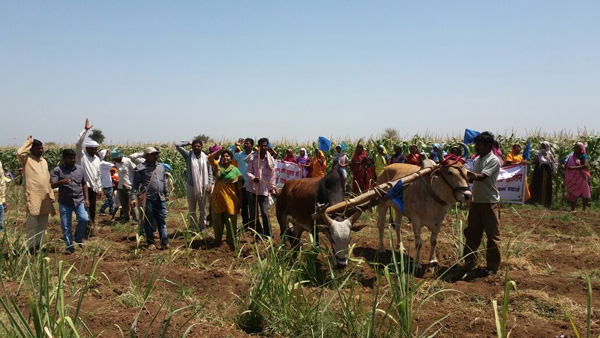Narmada Dam: Maharashtra families get compensation 36 years late,many still left out

Building mega dams, which displace lakhs of people, from thousands of villages, comes with the responsibility of ensuring that the rehabilitation process goes on without a hitch.
But this has been an afterthought at worst for the Sardar Sarovar Dam on the Narmada. The 50,000 families (by the most conservative estimate) displaced by the dam in Maharashtra, Madhya Pradesh and Gujarat, are facing a raw deal.
With their lands submerged in the dam's waters, many are yet to receive their rightful compensation, although conditions for rehabilitation were fixed way back in 1979.
Also read: FIR against photographer Manik Katyal after intern alleges molestation
Rehabilitation process
On 1 April, the long wait of several families in Nandurbar district of Maharashtra, came to an end. Around 2,000 families were given land. This includes land to build a home, as well as agricultural land. This is a little over 36 years after the terms of compensation were first outlined in the Narmada Water Disputes Tribunal's Award on 12 December, 1979.

Construction on the Sardar Sarovar Dam in the western state of Gujarat continues day and night despite the heat-waves across the country. Photo: Sam Panthaky/AFP/STRDEL
This is just a silver lining to an otherwise snail's pace rehabilitation of the displaced in all the three states.
Even in Maharashtra, this rehabilitation was fraught with errors.
According to a note by the Narmada Bachao Andolan - which has been fighting for the dam oustees for close to three decades - many were given land 10 years ago but were never told about it. The note cites the case of one farmer, Atya Devji Padvi.
Padvi was allotted land by the government but was never told about it. He found out only four months ago. It was after he wrote to the state's Grievance Redressal Authority (GRA) for the oustees that an alternate land was allotted to him.
That, though, turned out to be in the name of another dam oustee, who had originally been awarded land in Gujarat. Finally, the matter was resolved by officials from both Maharashtra and Gujarat states, and Padvi took possession of his land on 1 April. He is now 70-years-old.
Also read: Is National Green Tribunal going soft on Sri Sri Ravi Shankar's Art of Living?
Jha Commission Report
Here are some things to note about state of Madhya Pradesh:
- It receives the highest share of dam's waters
- Has the highest number of affected families
Its rehabilitation is also the most controversial
- According to government's records, 81% of affected families are from the state
There have been allegations of massive corruption during the rehabilitation process. In fact, the Jabalpur high court had set up a commission under Justice SS Jha, a retired judge, in 2008 to probe the irregularities.

Farmers in Maharashtra's Nandurbar district take possession of compensation land on 1 April. Photo: Narmada Bachao Andolan
The report has become a hot potato after it was submitted to the High Court. The state government said it should be tabled in the state assembly as per the Commissions of Inquiry Act.
The matter eventually landed in the Supreme Court. The SC, on 30 March, ordered that the High Court hand over the report to the state government by 9 April. It has asked the government to take actions on irregularities described in the report within six weeks.
The contents of the report are still confidential.
Also read: In numbers: less water means fewer water-related jobs
Continuing Struggle
Back in November of 2015, an 'independent people's tribunal' of four retired high court judges, estimated that around 2.5 lakh dam oustees were yet to be rehabilitated by the state governments. This includes around 16,000 families who are not officially recognised by the government as affected persons.
These families claim that their land is submerged when the dam fills up in the monsoon. On the other hand, dam officials disagree that the dam waters reach those heights.
The panel consisted of retired judges Panachand Jain (Rajasthan High Court), VD Gyani and NK Mody (Madhya Pradesh HC), and Nagamohan Das (Karnataka HC).
Also read: Ravindra Velip was arrested for protesting iron ore transportation in Goa. Why so?

Farmers had to wait for over three decades and correct bureaucratic errors to get the land. Photo: Narmada Bachao Andolan
"We found that false evidence was created, forged documents were created to show resettlement. There is a large scale victimisation of people, and a violation of their human rights," Justice Jain said.
One reason for the states to show full rehabilitation, is that legally, it is a requirement for raising dam's height - something the government is keen on doing. Already it has permitted raising the height to 138 metres from the current 121 m.
Taller dam walls lead to more water and possibly more electricity from the dam.
It is no wonder that despite overwhelming evidence to the contrary, Madhya Pradesh and Gujarat have claimed that the rehabilitation process is complete.
Edited by Sahil Bhalla
More in Catch:
Is World Bank above the law? Aggrieved Gujarat fishermen find out it is
Four extensions later, India coastal management plan still in tatters







![BJP's Kapil Mishra recreates Shankar Mahadevan’s ‘Breathless’ song to highlight Delhi pollution [WATCH] BJP's Kapil Mishra recreates Shankar Mahadevan’s ‘Breathless’ song to highlight Delhi pollution [WATCH]](https://images.catchnews.com/upload/2022/11/03/kapil-mishra_240884_300x172.png)

![Anupam Kher shares pictures of his toned body on 67th birthday [MUST SEE] Anupam Kher shares pictures of his toned body on 67th birthday [MUST SEE]](https://images.catchnews.com/upload/2022/03/07/Anupam_kher_231145_300x172.jpg)






